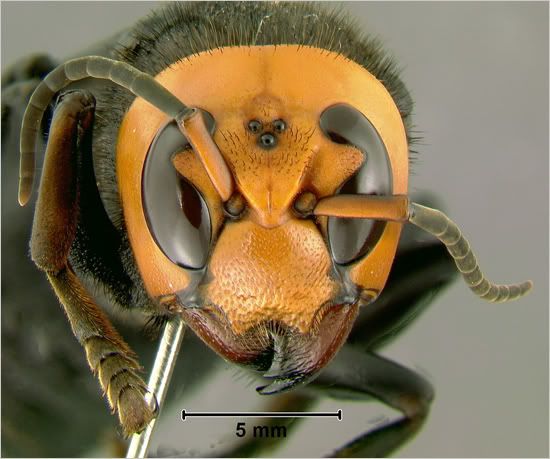You are using an out of date browser. It may not display this or other websites correctly.
You should upgrade or use an alternative browser.
You should upgrade or use an alternative browser.
Mate has BEES Help!
- Thread starter easyrider
- Start date
More options
Thread starter's posts
Japanese Hornet is watching you, and plotting against you!
Thats one mean looking *******

Soldato
- Joined
- 5 Sep 2005
- Posts
- 11,742
- Location
- Northern Ireland
1) Get camcorder
2) Pint at underground lair and hit record.
3) Jump on their underground lair. Lots.
4) ????
5) Post on Youtube
6) Receive instant internet fame for a few minutes.
7) Wait a few months.
8) Receive stern letters from some Health and Safety prat.
2) Pint at underground lair and hit record.
3) Jump on their underground lair. Lots.
4) ????
5) Post on Youtube
6) Receive instant internet fame for a few minutes.
7) Wait a few months.
8) Receive stern letters from some Health and Safety prat.
Man of Honour
- Joined
- 1 Aug 2004
- Posts
- 12,681
- Location
- Tyneside
Are you sure it was Murder & not Rape.
Sounds like a job for the wildlife squad.
Give them a buzz malc.
Soldato
- Joined
- 18 Oct 2002
- Posts
- 9,637
- Location
- Xbox Live
Would setting it alight not completeley destroy his garden? and foundations.
A small price to pay
Are you sure it was Murder & not Rape.
Well it appeared to be slicing it apart so I guess murder, I got the wasp off then my mum squashed it with some rock, 5 mins later we seen the moth still alive, so had to stamp on it really hard to put it out of its misery.
Soldato
- Joined
- 19 Dec 2006
- Posts
- 9,262
- Location
- Saudi Arabia né Donegal
Tell me what country you found them in so that I never EVER go there.
* Sphecius antennatus (Klug, 1845) (Southern and Eastern Europe, Middle East, Central Asia)
* Sphecius citrinus Arnold, 1929 (South Africa)
* Sphecius claripennis Morice, 1911 (North Africa)
* Sphecius conicus (Germar, 1817) (Balkans, Kazakhstan, Turkey, Greece)
o Sphecius conicus creticus de Beaumont, 1965 (Crete)
o Sphecius conicus syriacus (Klug, 1845) (Syria to China)
* Sphecius convallis Patton, 1879 – Pacific cicada killer (California, Mexico)
* Sphecius grandidieri (de Saussure, 1887) (Madagascar)
* Sphecius grandis (Say, 1823) – Western cicada killer (Nevada, Arkansas, Colorado, Mexico)
* Sphecius hemixanthopterus Morice, 1911 (Algeria)
* Sphecius hogardii (Latreille, 1806) – Caribbean cicada killer (West Indies, Florida)
o Sphecius hogardii bahamas Krombein, 1953 (Bahama Islands: Bimini)
* Sphecius intermedius Handlirsch, 1895 (Algeria)
* Sphecius lutescens (Radoszkowski, 1877) (Central Asia)
* Sphecius malayanus Handlirsch, 1895 (Indonesia: Timor, Sumbava)
* Sphecius milleri R.Turner, 1915 (Zambia)
o Sphecius milleri aurantiacus Arnold, 1940 (Ethiopia)
* Sphecius nigricornis (Dufour, 1838) (Southern and Eastern Europe, North Africa)
* Sphecius pectoralis (F.Smith, 1856) (Australia)
* Sphecius persa Gussakovskij, 1933 (Iran, Afghanistan)
* Sphecius quartinae (Gribodo, 1884) (Guinea, Somalia)
* Sphecius schulthessi Roth, 1951 (North Africa)
* Sphecius speciosus (Drury, 1773) – Eastern cicada killer (Central and North America: Honduras to Canada)
* Sphecius spectabilis (Taschenberg, 1875) – South American cicada killer (Brazil, Argentina)
* Sphecius uljanini (Radoszkowski, 1877) (Kazakhstan, Turkmenistan, Iran)
Anywhere warm and with Cicadas

Edit: The first one is a Japanese Hornet iirc.
Last edited:
Well it appeared to be slicing it apart so I guess murder, I got the wasp off then my mum squashed it with some rock, 5 mins later we seen the moth still alive, so had to stamp on it really hard to put it out of its misery.
Might have raped it so hard it split it in two.

So to summarise.
A Well hung Wasp raped a Moth in your house today so your Ma got a Huge Flintstone size rock & set about it. In a final showing of Mercy you Stamped on the moth whilst it had it's last orgasm.

I thought they had reached southern England?
Probably, we get quite a lot that we never used to. I just stole a list from wikipedia.
Associate
- Joined
- 12 Feb 2003
- Posts
- 2,441
I'll show you a wasp!
http://www.flickr.com/photos/skrphoenix/3588539777/sizes/o/in/set-72157614305557307/
Caught that bugger the other week in the living room. Was FAST, NOT AFRAID and CLEARLY AGGRESSIVE.
I give you, the Pimpla Instigator Wasp. Native to England too....
http://www.flickr.com/photos/skrphoenix/3588539777/sizes/o/in/set-72157614305557307/
Caught that bugger the other week in the living room. Was FAST, NOT AFRAID and CLEARLY AGGRESSIVE.
I give you, the Pimpla Instigator Wasp. Native to England too....
Contact your local council Pest Control office. They'll provide advice and will probably deal with it (for a fee)
They don't deal with bees...Just wasps.
Jesus! We're all dead
On a serious note, I suggest two things that we have employed successfully on ants in the past ... I'm sure they'll work on bees/wasps similarly ...
1) boiling water. More suited to patios than soil, really.
2) soak petrol into the soil (the tunnels will help it all flow in), wait for a while, add some more to be sure and light it up. Instant cure.
not a great fan of wasps and bees soi vote for these and if u got kids get the experts in , i crapped myself when i saw the pix of the wasp on the hand :S







